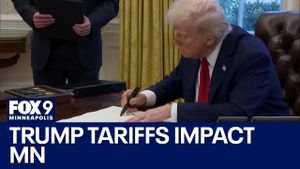The Vietnamese stock market experienced significant volatility as markets reopened after the Lunar New Year celebrations, with the VN Index taking notable dips and rises through the trading day.
On February 3, 2024, the market opened to stark realities, plunging as selling pressures dominated many sectors, particularly within technology stocks. The VN Index saw its steepest decline at 12.02 points, closing at 1,253.03, which registers as a considerable drop of 0.95% from previous levels.
According to reports from Tin nhanh chứng khoán, this downturn can largely be attributed to external factors influencing investor sentiment, echoing similar behaviors seen worldwide across stock exchanges. The selling frenzy was exacerbated by fears and uncertainties linking back to global economic movements, as leading stocks faced harsh evaluations.
Despite these significant challenges, the index focused on support levels, particularly around the 1,250 mark, holding steady enough to avoid substantial selling panic. Several analysts noted this stability signals resilience within the market even amid the apparent instability. “Dù giảm điểm trong phiên khai Xuân, thị trường vẫn giữ được sự ổn định khi không có áp lực bán tháo mạnh,” said Văn Hưng, offering insights on market pressures.
Trader behaviors reflected varied responses to the paired challenges of market dips and the traditional New Year sales. The average trading volume steadily reached nearly 15.4 trillion VND across all three exchanges, with HoSE accounting for roughly 14 trillion VND of this volume. This robustness shows some level of investor confidence and the potential for recovery as trading patterns involve seasonal adjustments.
Another interesting aspect to observe was the performance of smaller-cap stocks, which witnessed various gains even as blue-chip stocks struggled. Stocks such as GEX increased by 4%, HAH gained 3.4%, and HVN grew by 2.8%. This divergence within the trading strategies emphasizes the broader market's layered nature as participants scouted for opportunities amid sliding indexes.
Market movements can often serve as indicators of larger economic trends, and certain analysts view this current volatility as simply the market adjusting itself to post-holiday realities. “Nhiều mã hồi phục tốt trong phiên ATC cũng giúp giảm bớt sự ảm đạm của thị trường chung,” Văn Hưng notes. This perspective highlights the inherent cyclical nature of the Vietnamese markets, often aligning with broader economic principles observed throughout global finance.
The VN30 Index, which tracks the 30 largest companies listed on the HoSE, reflected similar trends with a substantial drop of 22.13 points. Major names such as FPT, VNM, and VPB lost ground, driving investor sentiment more cautiously as the New Year festivities wrap up.
Looking forward, investors are encouraged to identify opportunities for recalibration as the market adjusts to post-holiday trading conditions. Active investor engagement is often experienced after periods of significant celebrations, hinting at increased activity as participants return refreshed and with new strategies. The upcoming week holds promise for reassessment of holdings and perhaps targeting underperforming stocks for recovery as economic assessments reshape discussions on future acquisitions.
The overall performance following the Lunar New Year is often viewed as reflective of broader economic sentiment. The hope now lies within the potential for gradual recovery and more favorable statistics as yield adjustments take place.



